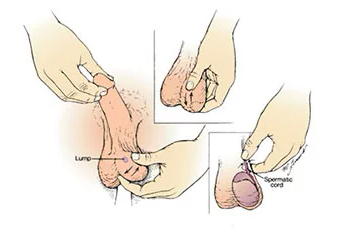Men are encouraged to self-examine their testicles to check for abnormalities that may indicate testicular cancer. WARNING: This article contains a graphic guide to testicular self-examination.

Testicular cancer is most common in young men aged 15–39 years. In South Africa, fortunately, the five-year relative survival rate is over 95%.
Early detection however, is very important – that starts with self-examination.
But what do men need to look out for while self-examining these oval-shaped glands?
You can get cancer in one or both testicles, two egg-shaped organs inside the scrotum, the loose sac of skin behind the penis.
According to the NHS, men should self-examine their testicles once a month, starting at puberty. Experts see this as an effective way for men to get to know their bodies and recognise any abnormalities that may indicate testicular cancer. In women, self-examination has proven to be very helpful in detecting early breast cancer.
 This is how to do testicular self-examination:
This is how to do testicular self-examination:
- Stand in front of a mirror.
- Check for any signs of abnormal swelling.
- Examine each testicle with both hands.
- Place the index and middle fingers under the testicle with the thumbs placed on top.
- Roll the testicle gently between the thumbs and fingers (you shouldn’t feel any pain while doing this).
Abnormalities
If while examining your testes you discover a lump or any form of swelling, don’t be alarmed. The NHS reports that these symptoms are common among men and boys and can have many different causes.
Some of the causes may be:
- Varicoceles – swelling caused by swollen and enlarged veins within the scrotum
- Hydroceles – swellings caused by a buildup of fluid around the testicle
- Epididymal cysts – lumps caused by a collection of fluid in the epididymis (a coiled tube behind the testicles)
- Epididymo-orchitis – inflammation of the epididymis and inguinal region
- Hernias – where fatty tissue or a part of your bowel pokes through into your groin, which can cause the scrotum to become enlarged
In most cases these lumps are not cancerous, but in rare cases they can be a sign of testicular cancer — and should therefore be checked out by your GP.
Other symptoms to alert your GP about:
- Any enlargement of a testicle
- A significant loss of size in one of the testicles
- A feeling of heaviness in the scrotum
- A dull ache in the lower abdomen or in the groin
- A sudden collection of fluid in the scrotum
- Pain or discomfort in a testicle or in the scrotum
- Enlargement or tenderness of the breasts
Prostate cancer
Prostate cancer is another cancer especially older men suffer from. It is a very slow-growing cancer and many men who die from other causes are found to have had prostate cancer without being aware of it. In the early stages of prostate cancer, there are usually no symptoms. However, in more advanced stages, the following symptoms may present:
- A frequent need to urinate
- Painful or burning urination
- A weak or interrupted flow of urine
- Difficulty starting or stopping urination
- Difficulty having an erection
- Painful ejaculation
- Blood in the urine or semen
- Pain in the lower back, hips or upper thighs
Experts encourage men to get tested at least once a year as soon as they reach 40.






